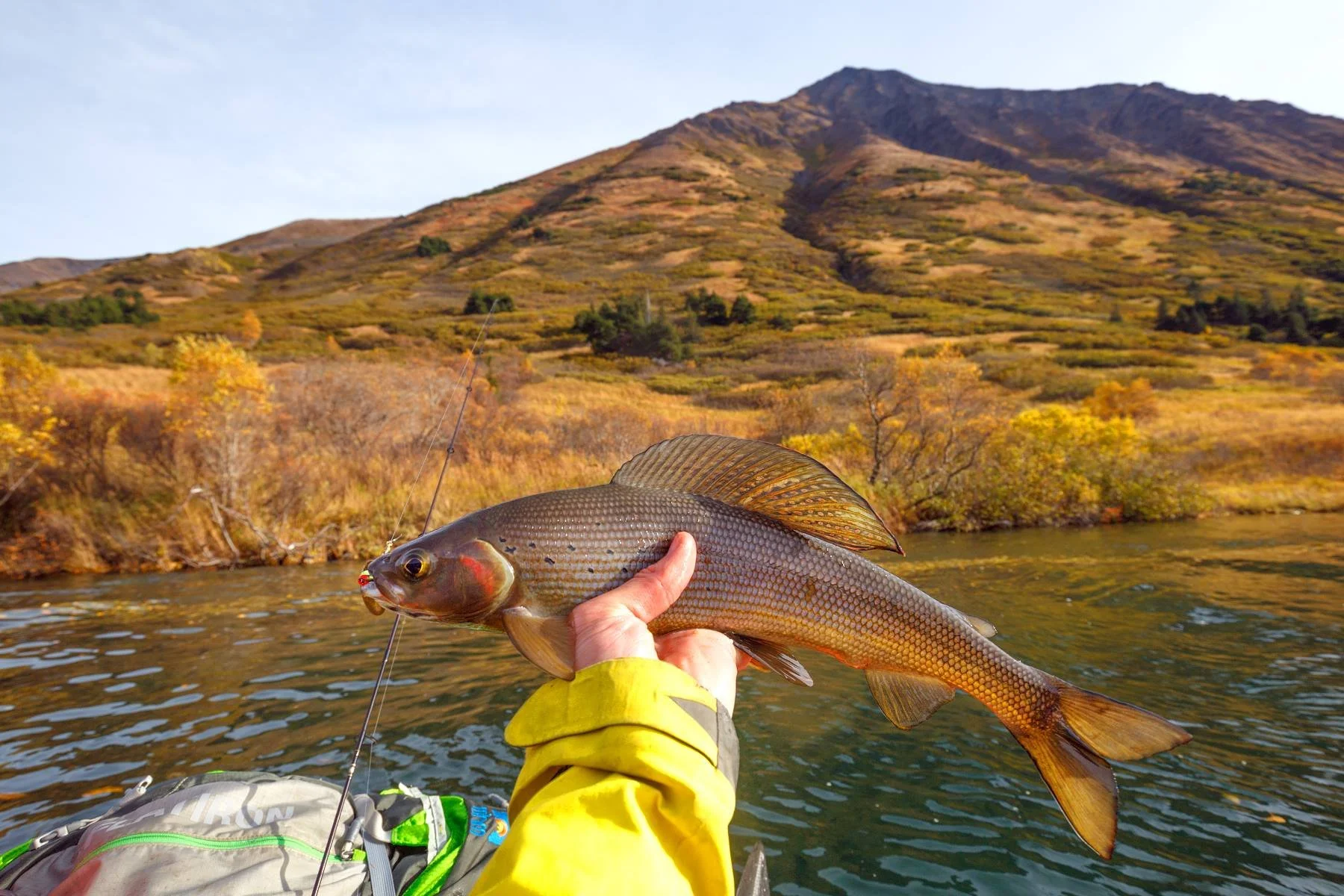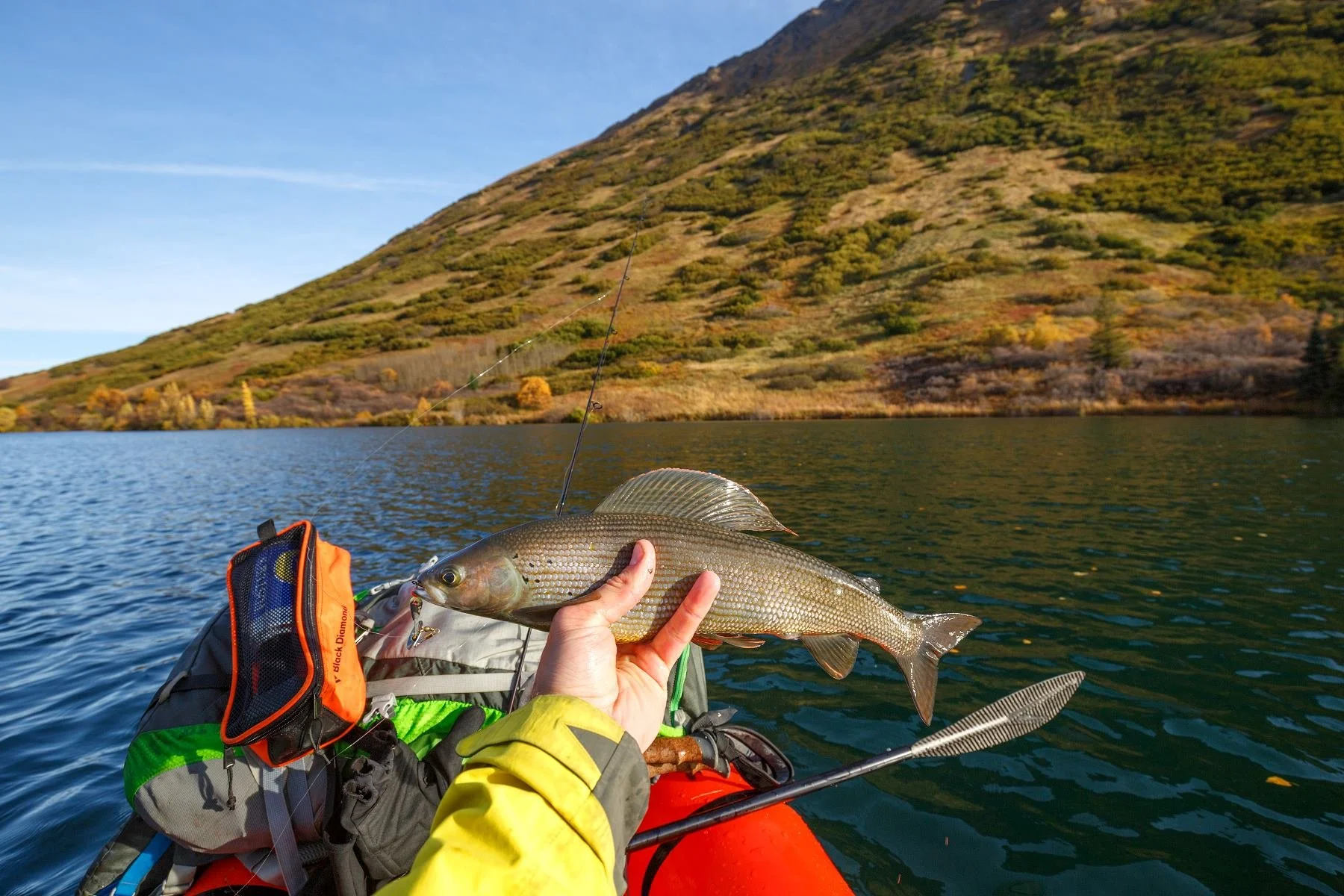A beauty grayling from Crescent lake near Cooper Landing
Trip Report:
Who: Solo trip
What: Back-country Packraft Fishing and camping on Crescent Lake
When: September 30th - October 1st 2017
Where: Cooper Landing, Alaska
Why: Catch an Arctic Grayling, Use my new Alpacka Scout, camp, and take awesome photos.
September 30th 2017
Today I hiked to crescent lake near the town of Cooper Landing in Alaska. The trail was relatively easy compared to other hikes I had done in the area. The route meandered uphill for about 6 miles towards the lake. The trail seems to be popular with mountain bikers and there is also a public use cabin that anyone can rent.
The weather was beautiful. It was a crisp fall day with blue skies and not a cloud in sight; in a sense it was perfect. I've always wanted to come here to fish for Arctic Grayling and today was my chance. I first learned about this area from an old fly fisherman in Homer. He raved about the Grayling fishing in this lake. I could tell by our conversation his passion was fishing so I trusted his advice. One thing he reminded me about more than once was to practice catch and release at this lake. The fish were ‘big, beautiful, and ancient’ as he put it. They were not meant to be eaten, but to be appreciated.
Another reason I wanted to go to crescent lake was to use my new packraft. I recently purchased an Alpacka Scout for exploring calm waters in the backcountry. I was eager to get out and use it before winter set in. I worked hard at the hospital as a housekeeper all summer and I saved up just enough money to buy it (the hospital paid for half with an incentive per-diem for fitness equipment) I also purchased an ultra-light carbon paddle as well as a mini life-jacket which weighed only 1 pound.
Hiking with the packraft wasn’t that big of a deal. it is super light at only 2.5 lbs and it didn’t slow me down while hiking. Although I was a bit nervous about using it for the first time. I had practiced inflating it at home but didn’t have a chance to paddle it anywhere. I also practiced strapping my bag to the bow of the raft. To make it functional I did some custom work on the bag. I cut the edges of an old backpack and retro-fitted a 60 liter dry-sack into it. It would keep my camping gear dry while I paddled. The design was inspired by some expensive packrafting bags I had seen online. My iteration wasn’t perfect, but it got the job done.
Once I had successfully inflated the raft and secured my dry-sack backpack on the bow I waded out into the water and pushed off from shore. In an instant I was scooting away from the trail and into the wilderness. The little raft handled much better than I had expected. I was in awe – the water was calm and glassy and made for easy paddling. The sun was starting to get low in the sky so I prioritized exploring instead of fishing.
I paddled for close to 2 hours before finding a spot to camp. The shoreline has steep banks with thick brush. There were also many stumps which made it difficult to find a place to pitch my tent. Eventually I found a suitable shoreline flanked by a picturesque lagoon. The water was turquoise blue, and I could see the sandy bottom through clear water. The entrance to the lagoon was protected by a small peninsula of spruce trees. I also chose this spot because of the photographic potential. There were calm teal waters in the foreground, trees in the mid-ground with a background dominated by mountains. Fog began to roll in on top of the water as I set up camp. I took a few photos and suddenly I heard a booming rock-slide in the mountains above. I saw tumbling rocks and a cloud of dust. I wasn’t in any danger, but it was a good reminder that nature can be dangerous.
In the evening I fixed myself a modest dinner of ramen noodles. I boiled the water in a big Fosters beer can with the top cut off. it was an ultra-light cookpot on a budget. I also brought a candle lantern with me on this trip. It certainly isn’t ultra-light, but I wanted to try a different piece of gear out. The warm light made my tent feel a little cozier than usual.
obligatory selfie with my. Attached to the bow of my boat is my improved dry-sack backpack. my seat was an inflatable camp pillow.
October 1st 2017
I woke up to frost covering the landscape. Everything was coated. including my tent. it was cold last night! I lit my little candle lantern and it did a good job of drying up the condensation in my tent.
When I got up for breakfast I was again greeted with the view of the lagoon. The fog and mist had stuck around from the night before and I pulled out my camera and began shooting the sunrise. Every so often a loon would cry out through the mist and fog and I could see shadows of fish swimming against the sandy bottom of the lagoon in front of me. I felt grateful for having the chance to live in such a beautiful state. Alaska never disappoints.
A view of my private lagoon
After getting my fill of photography i returned to my tent where my little candle lantern had been diligently heating the small interior. It was noticeably warmer inside my tent when I crawled inside. I scarfed down some cereal and coffee and then torn down camp. I then secured my big dry sack to the front of the raft and took a little victory photo before pushing off.
As paddled, I noticed the sun was now fully illuminating the mountains and the fog had been replaced by a steady wind. I paddled near the edge of the lagoon to stay out of the breeze and readied my fishing pole. I worked the shoreline with numerous lures and had no luck. I tried Swedish pimples, Mepps spinners without a single bite. I finally tied on an old panther martin that I disliked. I didn’t have a good reason for my disdain; the color just didn’t appeal to me. I surveyed the shore looking for a spot to cast my ugly lure. I saw a small birch tree hanging out over the edge of the shore. It caught my eye because it was shining brightly in the sunlight reflecting its yellow fall foliage. The wind picked up and blew a few of its iridescent leaves into the water in front of me. I cast my line into its reflection on the water. As soon as I began reeling in the slack, I had a fish strike! I laughed with excitement. My first Arctic Grayling! I could tell it wasn’t very big by the tug on the line. As I reeled it in along the side of my boat it slipped off the hook. I was a little disappointed, but I was still excited to have something bite.
As soon as I retrieved my spinner I cast in the same spot towards the tree’s reflection and again I had an immediate strike! This time I could tell the fish was much bigger. It put up a fight on my lightweight tackle. I managed to land this one with a small net I had packed. I picked the spinner out of its mouth and briefly lifted it out of the water for quick photo. Its sail-like fin popped up and it almost felt like the fish was trying to show off. It wasn’t as colorful as some of the fish I had seen in photos but it was still beautiful. I spent the rest of the morning paddling the shoreline back to where I had left the trail system. I had probably a dozen hits and landed about half of those fish. One of them was particularly large measuring about 16 inches long and its tall dorsal fin had bright red spots. As I let the fish go the wind began to whip up and small white caps were forming on the lake. I knew my little packraft wasn’t meant for rough water so I decided to call it a day. Luckily the wind was at my back I paddled back with a big grin on my face ready for my next packraft adventure.
One of the many Grayling I landed from my packraft. A bonus tidbit: you can see my Foster beer can cookpot




